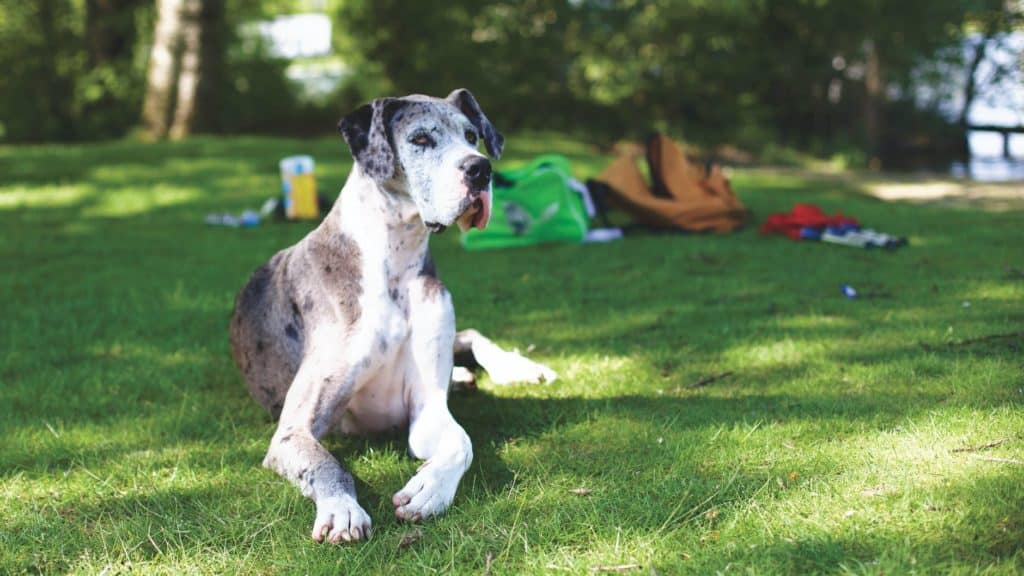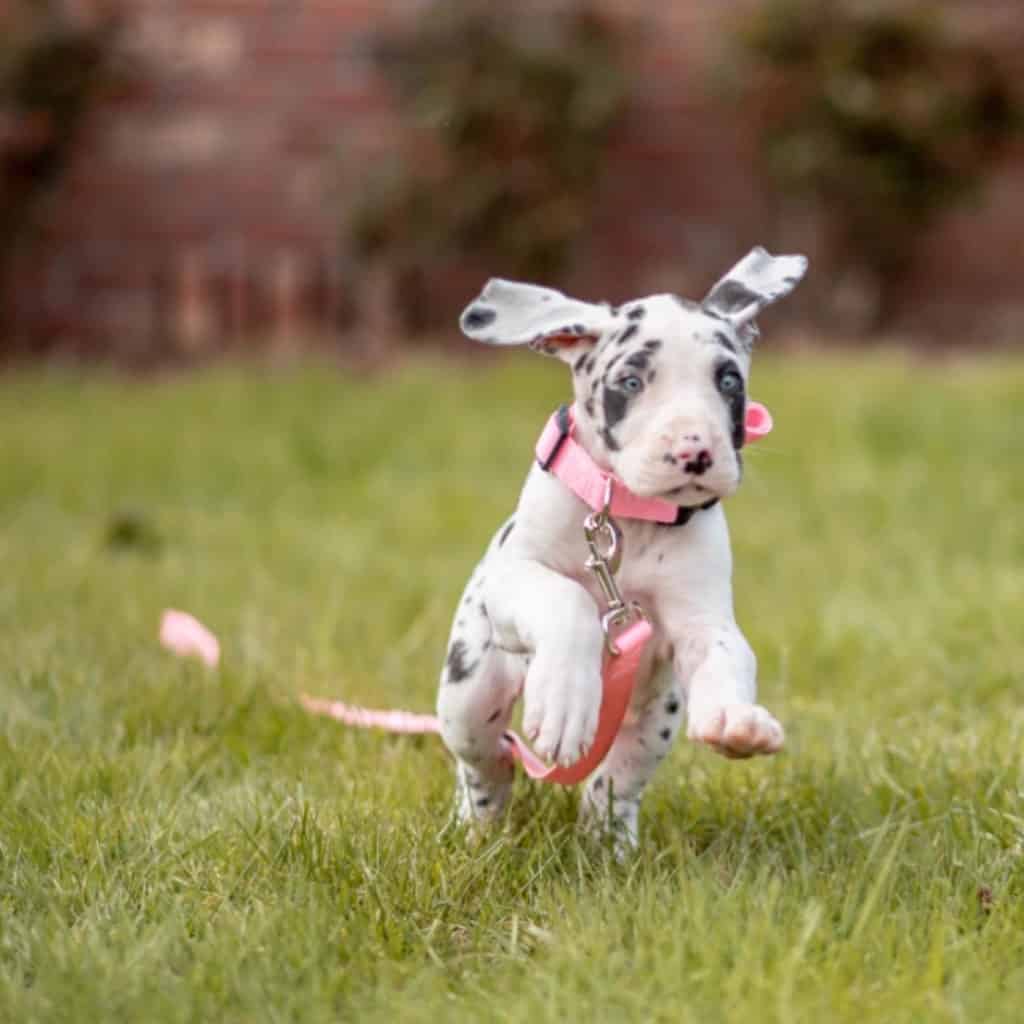If you’re the proud owner of a Great Dane, you know that they can be a handful on a leash, especially if you don’t work on obedience training with them! Today we’re talking about how to find and choose the best prong collar for a Great Dane.
These can be a great tool to help train and control your Great Dane, and no, it’s not abusive to use one!
In this blog post, we will discuss everything you need to know about prong collars for Great Danes.
What is the Best Prong Collar for a Great Dane?
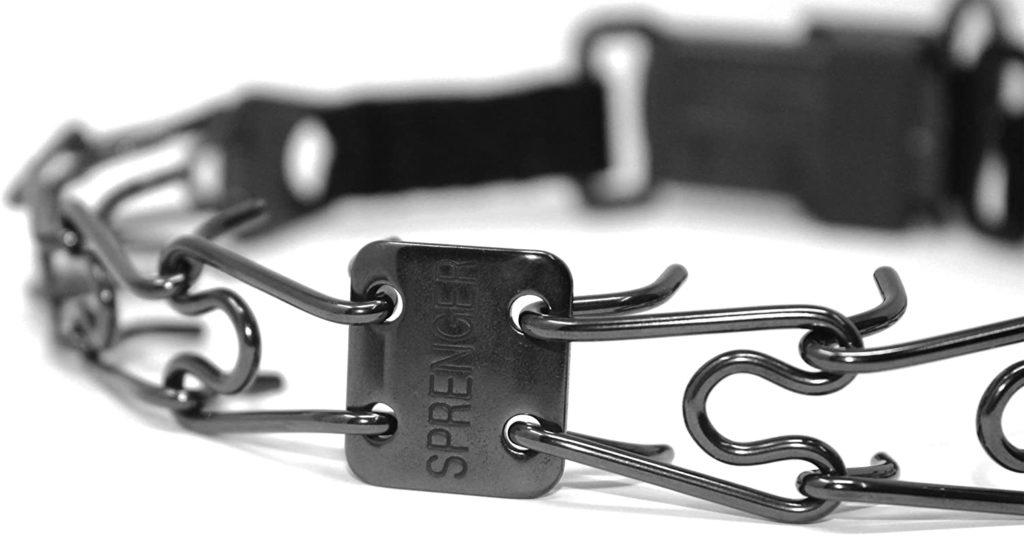
All About this European Brand
We only recommend the Herm Sprenger prong dog collars, from Germany, for Great Danes because they have been designed correctly to be used as a pressure tool, NOT a poking and stabbing tool.
The ends of each prong must be rounded, not sharp. Sharp pointy ends are a sign that you’ve purchased a knock-off or cheap collar, and those can and do hurt your dog.
Herm Sprenger has been around since 1892, and they’re still the best on the market.
Best Training Treats for Great Dane Puppies
Why is Leash Training so Hard?
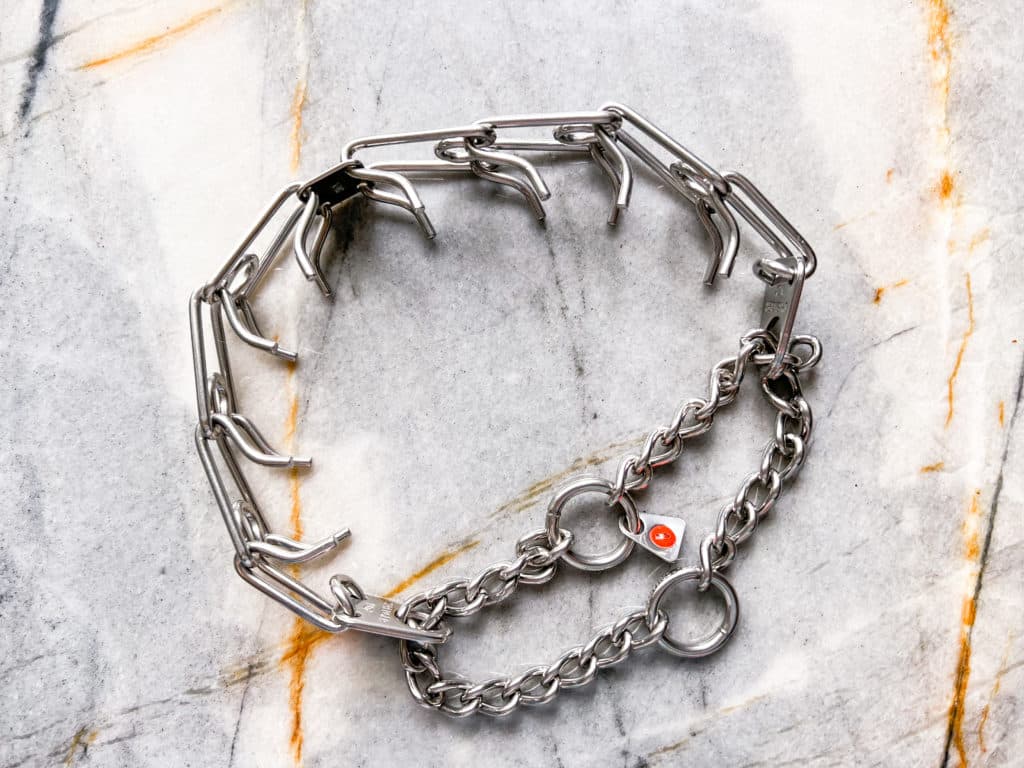
Sizing a Prong Collar for a Great Dane
The training collar comes in sizes 18″-26″. The size you need will depend on the circumference of your dog’s neck.
To find out what size your Great Dane needs, measure their neck where the collar will be placed (high and tight behind the ears) and then add 2″.
Order the size that most closely matches this measurement, and then remove or add links as necessary to achieve a perfect fit.
You will notice that they also come in different widths, from 2.25mm to 4.0mm.
www.leerburg.com, one of the most reliable sources of balanced dog training gear, would size most Great Danes into a 3.0-4.0 Large or Extra Large training collar.
Or choose the smaller 2.25mm size and add several additional links to fit.
https://leerburg.com/fit-prong.htm
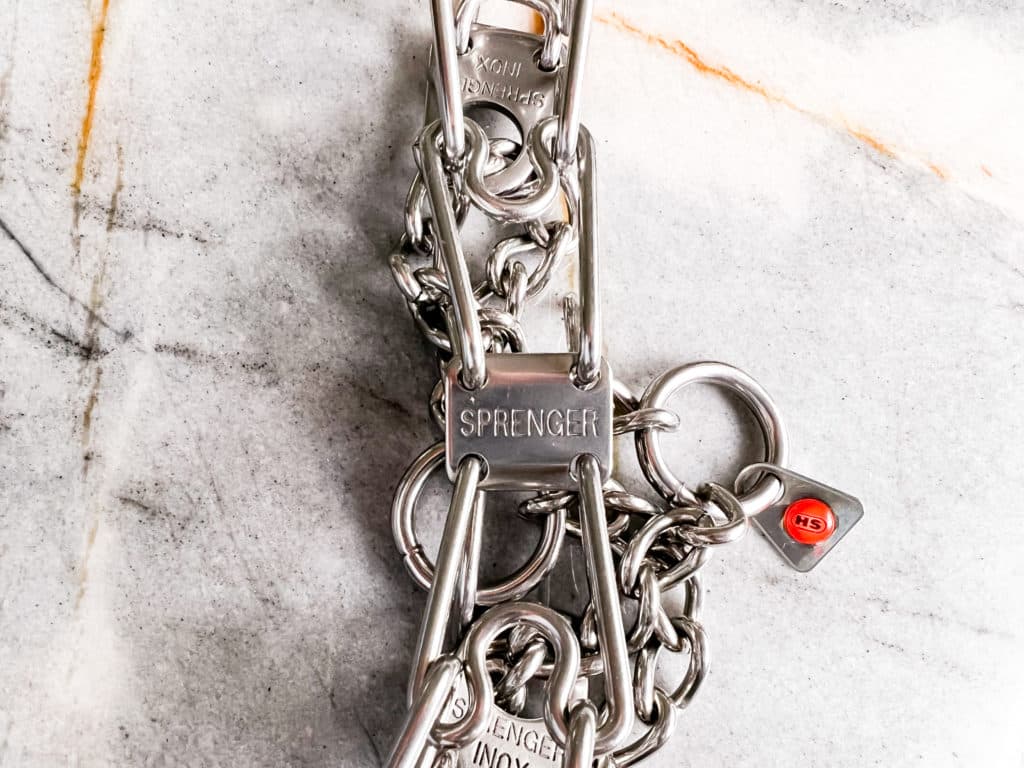
Prong Dog Collars from the Pet Store
A prong-type collar from the pet store may harm your dog by poking and stabbing them.
This is what gives these training tools such a bad name! Many dog owners have been misled to believe that you should never use a prong dog collar for a Great Dane because it is somehow abusive, and this is why.
The pet store versions and bargain options on Amazon are usually made of cheap materials that may wear quickly and break. If you’ve ever heard of people losing their dog because the prong collar broke, this is why!
If you’re going to use a prong collar on your dog, it’s important to get one that is high quality and will not hurt them.
How to Stop a Great Dane from Jumping Up
How to Teach a Great Dane to Walk on Leash
Is the Gentle Leader an Abusive Tool?
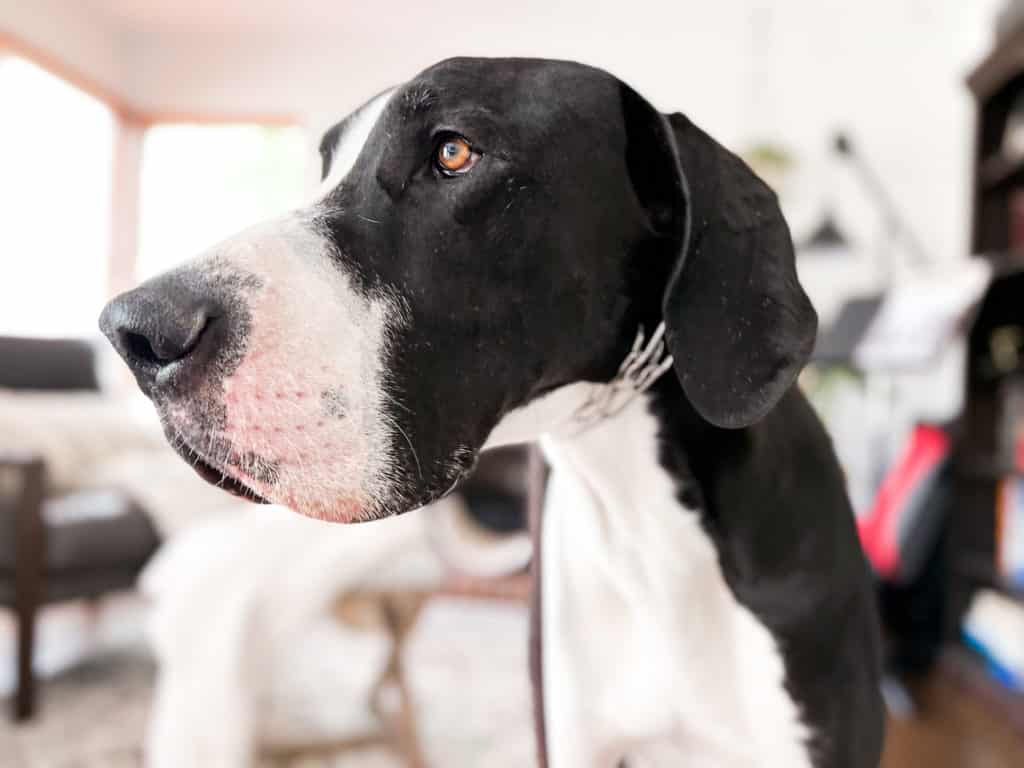
Starmark Training Collar vs. Prong
The Starmark training collar is essentially a version of prong-style collars that are made of plastic. It has plastic nubs that are blunt, not sharp.
The Starmark is a good option for those who are opposed to using a pinch collar on their dog but still want the benefits of a training collar.
We don’t recommend them, however, for dog parents who have dogs that pull and lunge wildly, as the plastic parts may not hold up to that.
How do Prong Dog Collars Work?
They work by placing pressure evenly around the neck when your dog pulls. This is different than a traditional collar, where the pressure from pulling and lunging goes straight into the trachea at the front of the throat.
A properly fitted prong should only tighten enough to cause discomfort, not pain. While the spikes look scary and painful, they are not meant to stab or poke!
We believe that these, and the modern E-Collar, are some of the best Great Dane collars and training tools available.
What is the Difference Between an E Collar and a Shock Collar?
9 Reasons to E Collar Train Your Great Dane Puppy
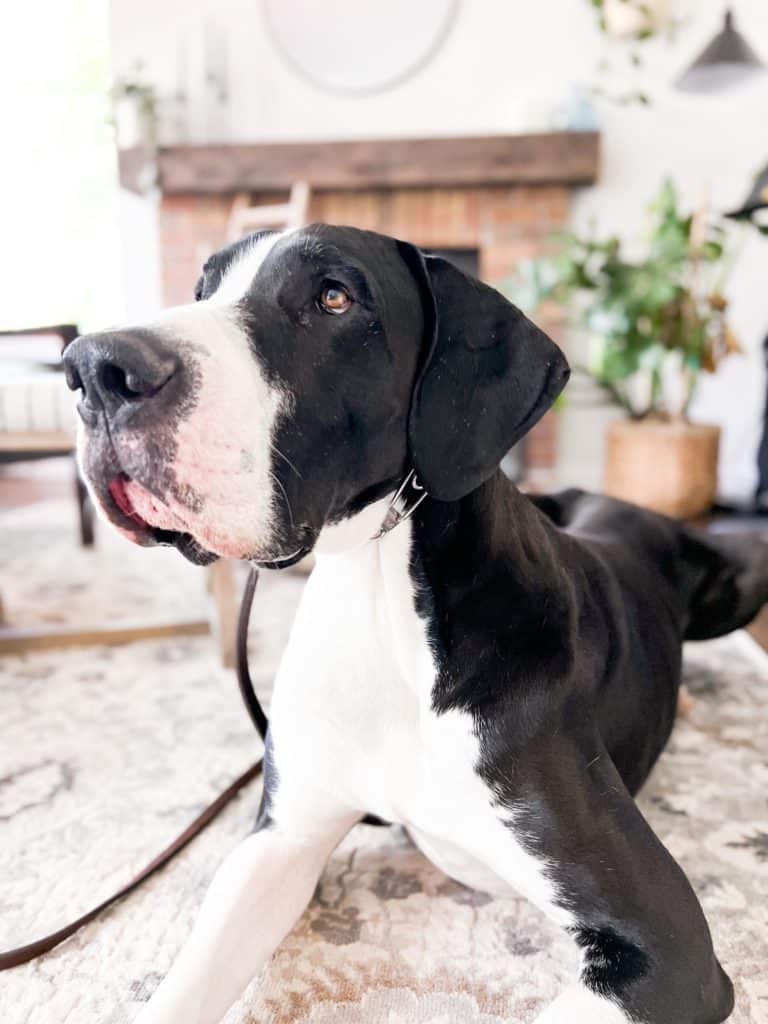
When & Why to Use a Prong Dog Collar
A correctly used prong is actually one of the most humane and effective tools you can use to train your dog.
One of the key benefits is that they are so effective at stopping pulling that your dog will no longer injure themselves or cause pain and damage to their trachea, neck, spine, shoulders, or chest.
A prong training collar is effective at accomplishing this, without being needlessly harsh, painful, or frustrating to your giant breed dog.
We recommend using this tool for your Great Dane when:
- Your dog is able to do basic obedience commands such as sit, down, stay, and ‘look at me’ in a low distraction environment
- Your dog knows how to learn and is enthusiastic about training with you
- You have watched several videos on Youtube about “How to Introduce a Herm Sprenger Prong Collar“, and have a basic understanding of the method and how the collar works
- You yourself are calm and not frustrated with your dog
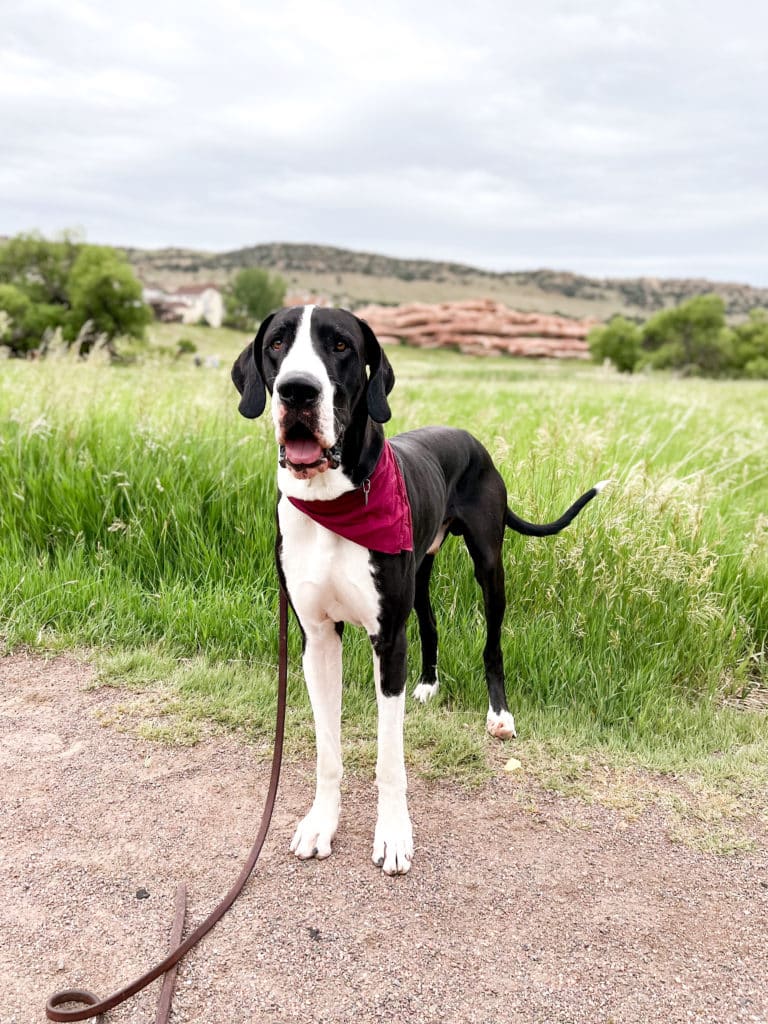
How to Fit a Prong on a Great Dane
The correct fit of training collars on your Great Dane is key. Great Danes have short fur, so it can be tricky to get the fit right.
The collar should sit high on the neck, right behind their ears.
It should be snug enough that it can’t slide over the dog’s head or off to the side, but not so tight that it is choking them.
You should be able to put a finger or two under the collar, while still having it snug enough that it doesn’t slide around.
You can add or remove links to your prong collar as needed to achieve this fit on your Great Dane.
It is important that you add and remove links in groups of two; one on each side of the trachea plate, so that the plate can still sit squarely at the front of the neck.
The chain loop and leash attachment point should be at the back of neck, right behind the ears.
An incorrectly fit prong will be painful, damaging and frustrating to your dog. It is the incorrect use of these collars that have led to animal rights groups lobbying to make them illegal. Do not contribute to this problem.
Great Dane: Puppy vs. Adult Food
What Foods Help a Dog’s Upset Stomach?
A Tasty Top: The Top 11 Foods to Feed a Great Dane
Should I Feed My Great Dane Grain Free?
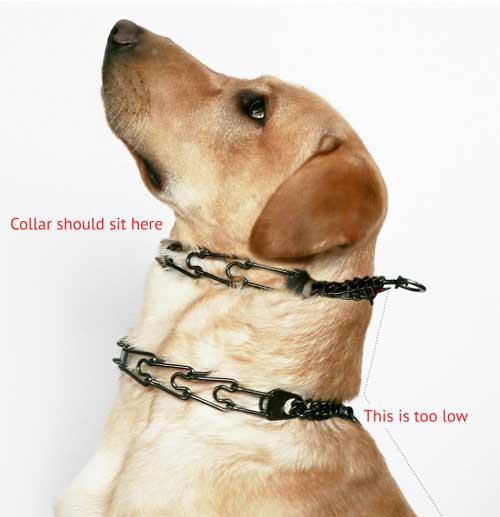
When NOT to use a Prong Collar
We do not recommend using this tool:
– on Great Dane puppies under the age of six months
– with Great Danes who are not adequately trained in basic obedience commands such as sit, stay, come, etc.
– on a dog or Great Dane puppy who is injured or recovering from an injury
-with Great Danes that are showing extreme fear and aggression that is not being first evaluated by a highly qualified dog trainer or credentialed behaviorist
Additionally, we do not recommend using this tool on your Great Dane if you:
-have an aggressive dog and are hoping to get them ‘in control’ by shutting them down with harsh corrections
-don’t have a basic understanding of how to use reinforcement to reward and teach behaviors
-aren’t willing to put the time into proper conditioning
-plan to use it to force a timid or fearful Great Dane into public interaction
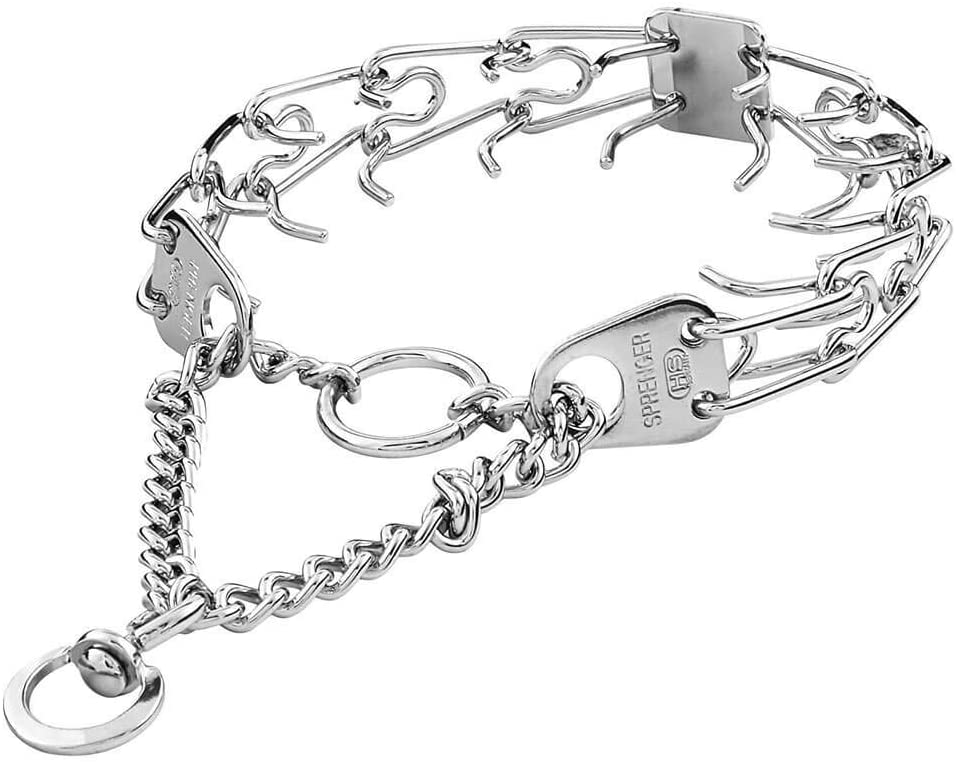
Positive Reinforcement + Pressure
Positive reinforcement (R+) is the basis for all good dog training.
You will use R+ to teach your dog to politely walk next to you (see the leash training 101 section, below).
With a combination of positive rewards (YES!) and pressure (NO!), your Great Dane will quickly learn not to pull or lunge on the leash.
R+ means to give your dog something they want (usually a treat) when they do something you want.
For example, if you are teaching your dog to ‘sit’, you will give them a treat when they sit. In this case, you will ask your dog to ‘heel’ and give them a treat for walking next to you.
The pressure part of this equation is the prong collar. It works by applying pressure to the neck when the dog pulls.
When they move towards you or stop pulling, the pressure immediately stops.
This will give your dog a “lightbulb” moment! The dog is in control of both the reward AND the pressure, it’s their choice. That’s what makes this one of the best training collar options available.
The pressure, when released, reinforces (increases) the behavior of removing tension on the leash.
When you make the choice of not pulling more valuable, and the choice of pulling less valuable, you effectively balance your training for your Great Dane.
9 Tips to Having a Trained Great Dane with Balanced Training
How to Help a Bored Great Dane
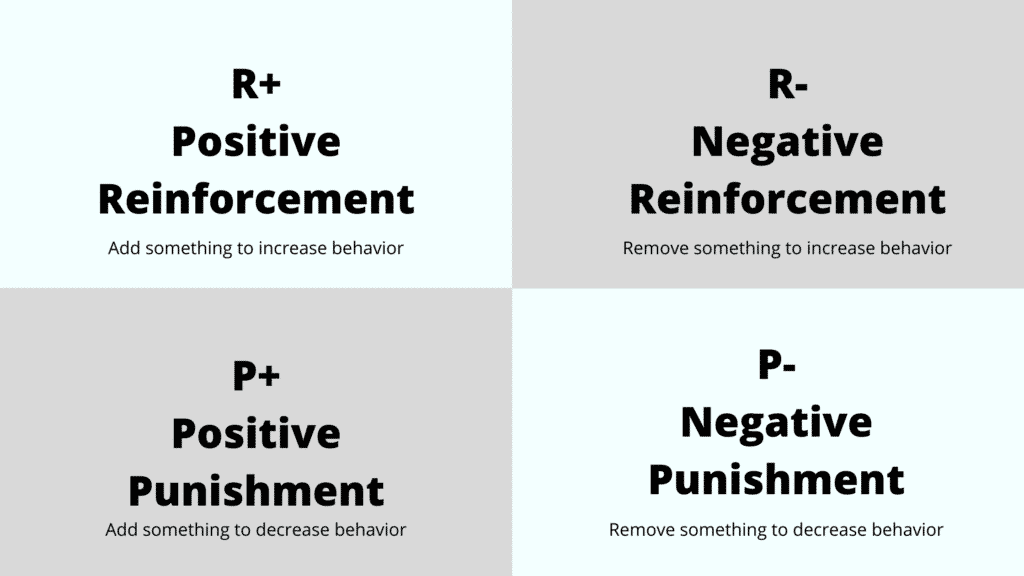
No-Pull Training Tools Overview
Here are some common and popular no-pull training tools. It’s important to keep in mind that there is no such thing as ‘positive’ training collars.
All tools, even harnesses, will rely on pressure, restrictions and force in some way. The difference is in how that pressure and force is applied.
When it comes to giant breed dogs, additional considerations are at play. Because Great Danes are prone to orthopedic problems, it’s important to find a tool that uses the least amount of restriction and force.
While the prong may look like a tool of pain and force, it’s surprisingly simple, elegant and gentle compared to the alternatives. We will dig into this more below.
Prong Collar
The Prong works by applying pressure evenly around the neck when your dog pulls. The collar should only tighten enough to cause annoyance, not pain. A flat collar will tighten and cause pain, but most dogs will ignore it even though it’s damaging. That’s where this tool is different.
This annoyance can be used to communicate ‘NO’ while you simultaneously reward YES using rewards.
Most dogs are incredibly responsive to the communication from a prong and learn very quickly that pulling and lunging is not an option.
Unlike other tools, a minimal amount of force is used.
Puppy Training: 5 Mistakes in Training
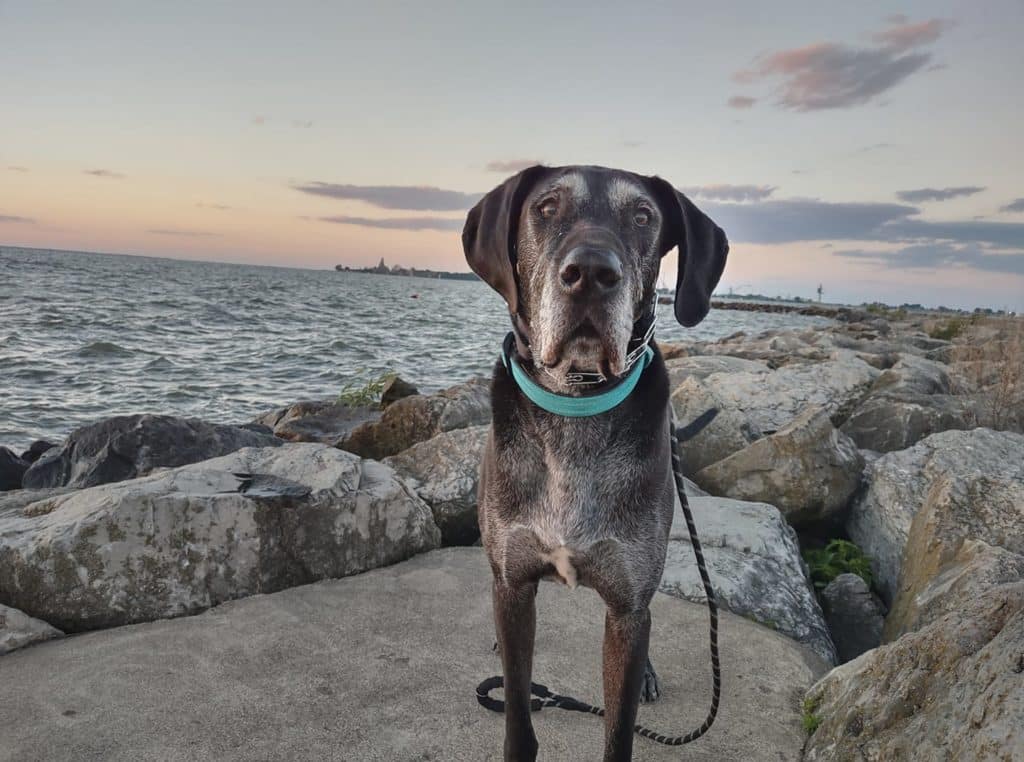
Head Collar
The head collar (AKA the “Gentle Leader” or “Halti Head Harness”) is a type of training collar that wraps around your dog’s muzzle.
Many people consider the head collar to be a “positive” and dog friendly tool, however, most Great Dane dogs find them extremely aversive and will paw, whine and scratch to get them off.
Additionally, because of how they are designed and how they work, head collars increase the risk of damage to the head, eyes, neck and sensitive facial nerves.
For some dogs and owners who are diligent about training, conditioning and appropriate use, they can be ok but for most people with giant breed dogs, we don’t recommend them.
Is the Gentle Leader an Abusive Tool?
Gentle Leader vs. Prong Collar: The Ultimate Match-Up
| Gentle Leader | Prong Collar |
|---|---|
| Aversive to wear, no matter the fit | Non-aversive to wear with correct fit |
| Requires conditioning for wearing & using | Requires training for using, not wearing |
| Looks ‘Gentle’ and seems positive | Looks scary and painful, but is misunderstood |
| Inexpensive | Spendy |
| Can damage nerves, eyes, neck, and spine when used normally | Can only cause damage to the skin if used abusively or incorrectly |
| May cause sores on the bridge of the nose | Does not cause skin sores or abrasions |
| People rarely judge this tool | People are often judgmental |
| May exacerbate underlying health problems | Unlikely to cause orthopedic damage |
| Dangerous for dogs with orthopedic issues, especially wobblers | An alternative choice for dogs who should not be pulling into a harness or collar for any reason |
| Negative body language is seen with normal ‘positive’ use | Negative body language is seen with harsh and incorrect use |
| Effective at reducing pulling | Effective at reducing pulling |
E-Collar
The E-Collar is different than a shock collar, and can be used to teach better leash skills both off and on leash.
E-collars are also known as “remote trainers” or “stimulation collars” and use a form of virtual pressure that replaces the sensation delivered through a leash. They are extremely gentle because they rely on absolutely no physical pressure at all. For this reason, they cannot physically harm your dog in any way.
We recommend the use of modern E-Collars for off-leash training, which will translate to better on-leash skills, too.
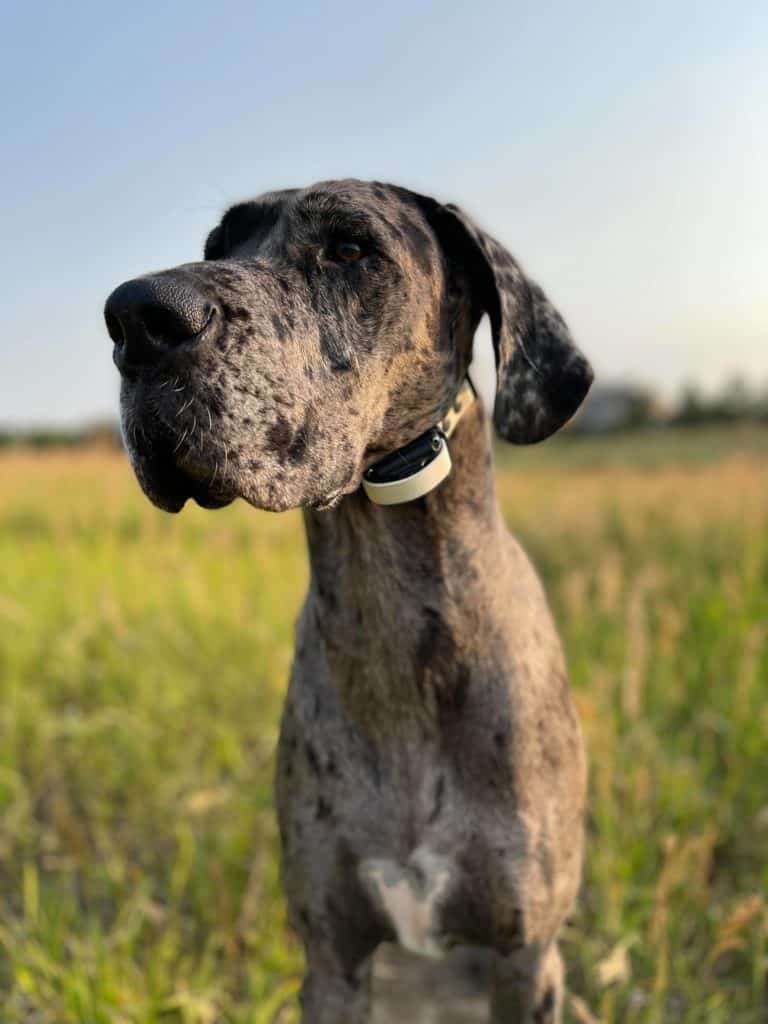
Front Clip Harness
The front clip harness (AKA the “Easy-Walk Harness” or “Freedom No-Pull”) works by restricting natural movement and applying pressure to the chest, shoulders and torso instead of the throat.
They can be an appropriate short-term solution for dogs with a minor pulling problem, but should not be used long term or relied upon.
Unlike other training tools, the pressure from a no-pull harness is constant whether the dog is pulling or not.
There is no clear communication as a result, and the fact that they work by altering the dogs ability to move naturally should be alarming to all Great Dane owners.
Is Positive Training Really Positive?
Flat Collar
Flat collars don’t do much to deter pulling. It is dangerous and uncomfortable for your dog to pull into one, and we only recommend flat collars for dogs that are 100% reliable both on and off-leash.
A prong is a much safer and more friendly alternative than a flat collar for dogs that pull. Use a leather collar to hold your dogs tags and be decorative, but don’t expect it to be the best or safest choice for leash walking.
When your Great Dane pulls, you want to know that they aren’t harming themselves (or you!), so consider other options when looking for the perfect collar your dog.
Chain, Slip or Choke Collar
These type of collars are NOT typically recommended for use with giant breeds.
They can cause damage to your dog’s neck, and because they rely on a form of harsh physical punishment, they can also lead to aggression problems.
The only effective way to use a collar like this to stop a dog from pulling is to either completely choke them with it or harshly snap the leash on the dogs neck. These are often unfair training methods, in our opinion, and likely to be a source of frustration and fear for your dog.
A good training collar will not require heavy-handed corrections, and these typically do.
All training tools do have their place, of course, including chain collars, and they should only be used with highly qualified professional guidance.
There is ONE exception to all of this. Slip leads and martingale-type collars are almost impossible for a dog to escape from and are highly recommended for dogs that are a flight risk. We recommend heavy, wide fabric martingale collars for Great Danes that might try to run away.
Leash Training 101
If you have a Great Dane that pulls, lunges and takes you for a walk, you’ve come to the right place!
This is Great Dane pinch collar training 101. Let’s get started!
The Basics of Leash Walking
When you are first starting out, we recommend working in a low distraction environment such as your yard or living room.
Teach and reinforce the skills of engaging with you, looking at you on command, and walking politely next to you.
This is easy to do using positive reinforcement!
Start off-leash with your dog next to you, and then give them the cue to “walk” or “let’s go”.
Take a step and as soon as they start moving with you, mark with a “YES!” and then offer a treat.
For dogs that are new to this process, you may have to start by luring them with the treat.
Add more steps in between treats until your dog can confidently walk next to you as you walk around obstacles.
Make this fun and rewarding for your dog by using high value treats, and soon you will have a dog that is happy to walk next to you!
Now let’s move on to the next step.
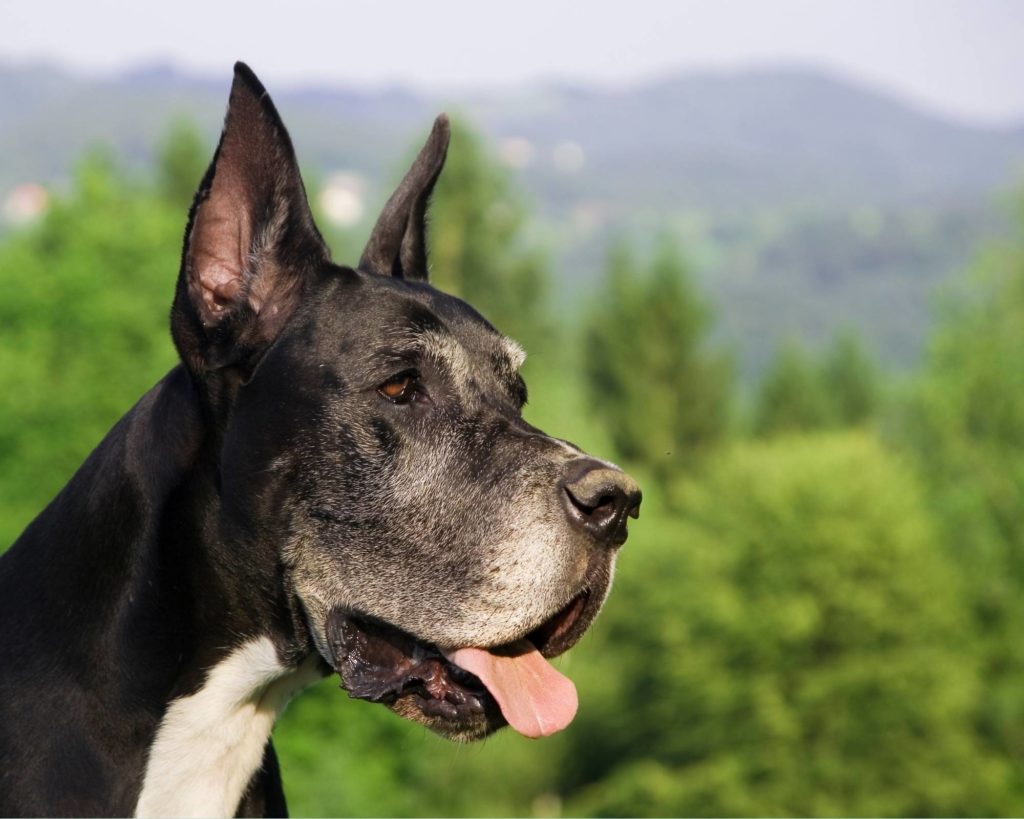
Teaching Prong Collar Pressure
Once your dog has a basic foundation of walking near you (the YES behavior), it’s time to upgrade.
As before, make sure you are using the right size Great Dane collar, fit high and tight.
Work first in a low distraction environment and make this process FUN!
The goal with this training is to teach your dog how to turn off the pressure from the prong. At no point will you yank your dog around, harshly correct them, scold them, or become frustrated.
With your dog in front of you on a leash, take a few steps back until the leash has some gentle tension on it.
Your dog will immediately respond to this pressure and come towards you. As soon as your dog ‘gives in’ to this pressure, mark with a “YES!” and then reward your dog with a treat.
You will find that your dog starts to offer this behavior more frequently as they understand that turning towards you and releasing tension on the leash makes the pressure go away.
Fun Games using Leash Pressure
Make this fun and zig zag, circle and move around objects to teach your dog that they are in control of the pressure from their collar! Use a lot of positive reinforcement and rewards for the YES behavior.
Once your dog is responding consistently, you can start to add in distractions by going out of your yard.
The key is to make sure that your dog is responding quickly and correctly to the pressure before moving on.
If at any point your dog becomes frustrated or seems irritated, confused or fearful, take a step back in your training and make it easier for your dog to succeed.
With patience and consistent reinforcement, your dog will learn how to turn off the pressure from the collar and be a happy, well-mannered companion on walks!
How to Stop a Great Dane from Jumping Up
How to Teach a Great Dane to Walk on Leash

Increasing the Skill
Once the foundation is built, you can begin to increase the skill level by visiting places that have more distractions.
Remember to keep it fun, and focus on rewarding your dog for the correct behavior.
Try visiting an open field where children are playing nearby, or walk through a quiet suburban street.
With time and practice, you’ll be able to confidently and calmly walk your Great Dane dog through busy areas including the farmer’s market or even past your neighbors (whose dogs bark and yell when you pass by).
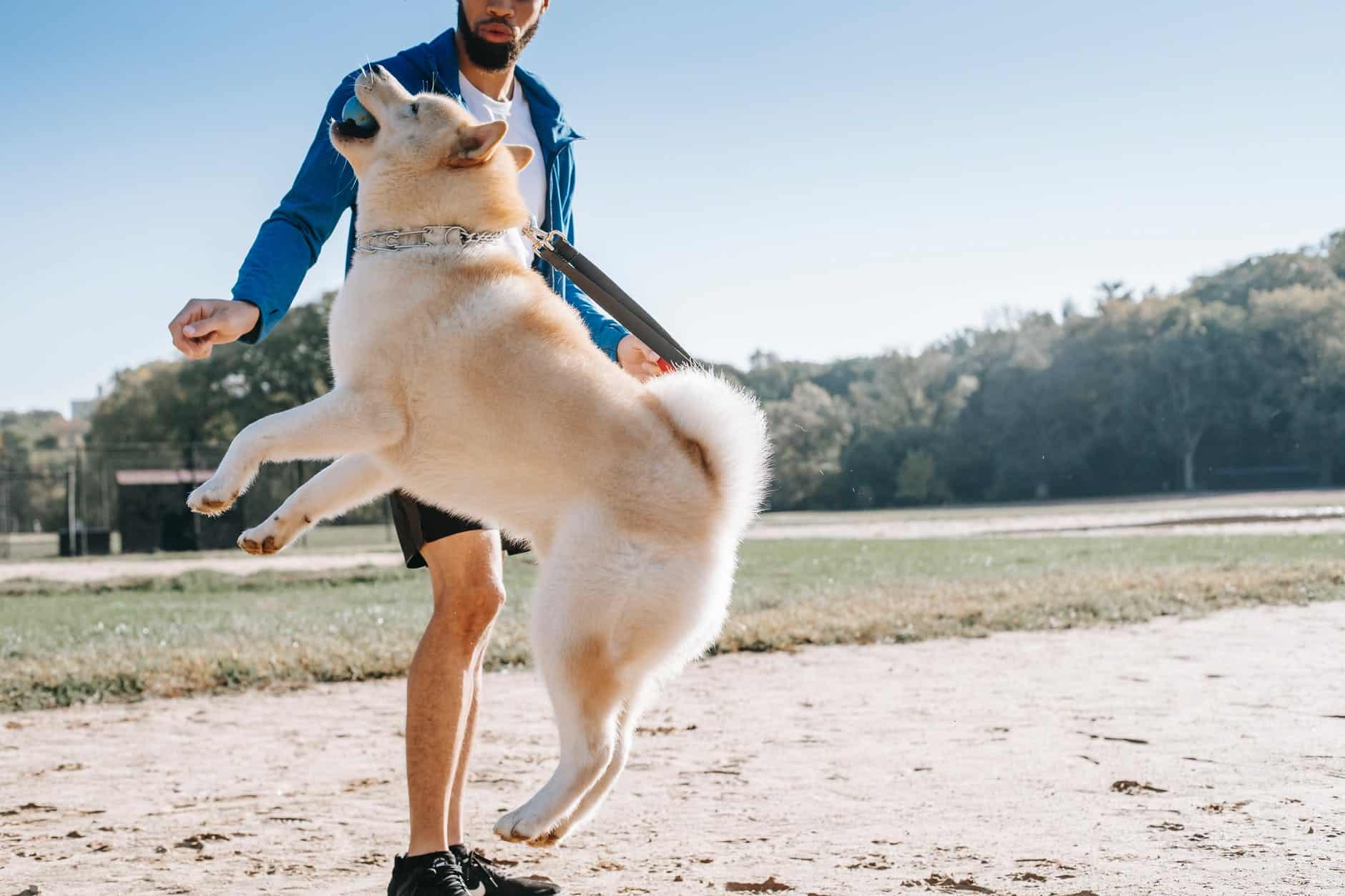
Avoid Reliance on Training Tools
The goal with most training tools is to eliminate reliance. This means that you should also continue to practice your leash walking skills without relying on pressure or corrections!
Start by walking in your yard or a quiet park, and gradually move to more difficult situations.
Corrections with Training Collars
If at any point you find yourself using more pressure than necessary, or if your dog is not responding as quickly as they should, take a step back and make it easier for your dog to be successful.
One thing to keep in mind when using a prong dog collar is that any ‘correction’ you do will be much more gentle than the correction your dog might experience from a halter, martingale collar or front-clip harness.
Do not use a heavy hand, in other words!

Great Dane Leash Training FAQ
Here are some answers to a few commonly asked questions when it comes to Great Dane training and choosing the best collar for a Great Dane.
Can I use a dog training shock collar and a prong at the same time?
No. Do not use any type of electronic collar (shock, e-collar, remote training collar) in conjunction with a prong dog collar. They are different tools and should be used for different reasons. Your dog can wear them at the same time, but make sure that your dog is taught to understand what each means.
We do recommend the use of E-collars for off-leash training, and the method is similar. Read more HERE.
How do I know if the collar is too tight or too loose on my Great Dane?
The general rule is that you should be able to fit two fingers between the links of the collar and your dog’s neck.
If the collar is too loose, it will be ineffective. If the collar is too tight, it will be uncomfortable for your dog and could cause injury.
Is a prong dog collar cruel?
No. When used correctly, a prong dog collar is a humane training tool that can help you teach your Great Dane leash manners!
Can I use a tool like this on adult dogs that already have bad habits?
Yes! It doesn’t matter how far behind you are with your dog training, choosing the right collar can be the difference between a successful training experience and a frustrating one.
Remember, the key is to keep it fun for your dog while consistently reinforcing the correct behavior. With time and practice, you’ll be able to walk even largest, most tenacious giant breed dog down the street on a loose leash!
A positive trainer told me that I was abusing my dog. Now what?
There is a lot of misinformation out there about dog training, and it can be difficult to sort through everything.
If you’re ever unsure about whether or not you are using a tool correctly, we recommend reaching out to a qualified trainer in your area for help.
The most important thing is that you and your dog are moving forward together in life, and enjoying the time you have!
For more information on how to choose an ethical, high-quality dog trainer, read HERE.
What does it mean when my Great Dane leans on me?
Random bonus question!
Leaning is often seen as a sign of affection, but it can also be a sign of insecurity or anxiety.
If your dog is leaning on you during leash walks, it’s likely that they are feeling a bit anxious and are looking to you for reassurance.
The best thing you can do in this situation is to remain calm and confident yourself, and to provide gentle reassurance as needed. With time and patience, your dog will learn to trust you, trust the process and feel more secure on walks.
Where can I get more information about Great Dane Training?
We offer a ton of blog posts and resources for training your Great Dane! Just click on our menus above to search topics.
You can also find us on Facebook and Instagram.
We love hearing from our readers, so please don’t hesitate to reach out with any questions or comments!

